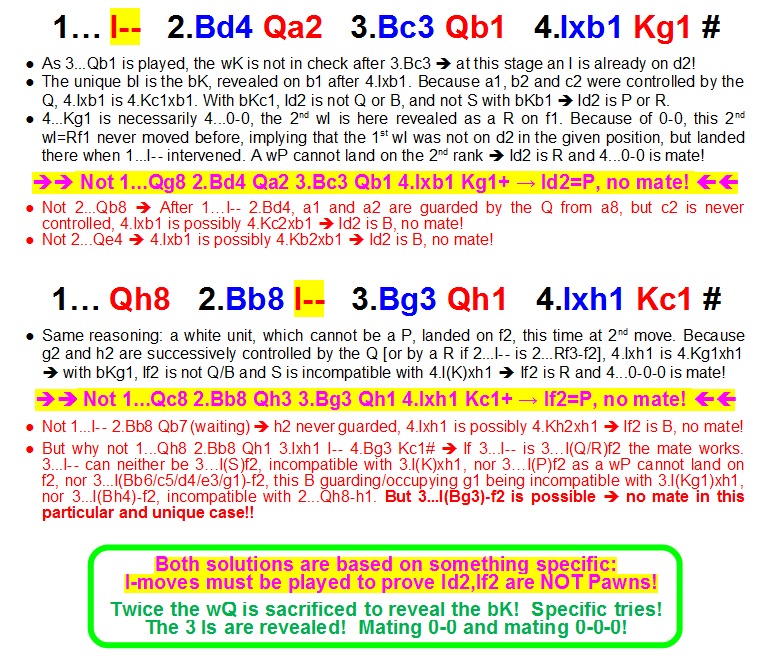
Original Fairy problems
JF-2020-II:
01.07.2020 - 31.12.2020
No. 1572 René J. Millour
France
original - 26.12.2020
white Qa8 Ke1
black Ba7
h#3.5 2 solutions 2+1
2+1 Invisibles
2+1 Invisibles
Solution: (click to show/hide)
Show detailed explanation by author: (click to show/hide)




Cook: 1.- Kc1 2.I– Kc2 3.Bb8 Ra1 4.Ixa1 Ixb8#
I wonder if the definition of Invisibles given here is exact.
> … or may capture a visible unit … to show its arrival square.
An arrival square can be shown by any capture, including all those made by an Invisible. The location is temporarily known (until that party’s next move by an Invisible to an unknown square (I–) took place). So why should an opponent’s Invisible not be allowed to capture that Invisible on the temporarily located square?
Note that this would mean additional cooks here, e.g. 1.- Kf1 2.Bg1,Bb8 ~ 3.Bh2 Ixh2 4.Ixh2 Qg2# or 1.- Qe4! 2.Bb8 Kf2 3.Bh1 Ixh2 4.Ixh2 Qh4(8?)#.
Second additional cook must be 1.- Kf2! (“wasting” 1 Invisible) 2.Bb8 Qe4! 3.Bh2 Ixh2 (the 2nd one) 4.Ixh2 Qh4(8?)#, sorry! This move order is prerequisite for an empty square h3.
No, it isn’t! In fact it works both ways. Feel free to confuse your own brain by checking why I was wrong! 🙂
Manfred, in the I-system an IxI-capture is not valid. For more, ask T.Wakashima, the inventor.
Only 1…Kc1 2.I– Kc2 3.Bb8 Ra1 4.Ixa1 Ixb8# is a real cook, explained as follows. 1…Kc1 is 1…0-0-0 revealing a wR on d1, coming from a1. To permit 4.I(K)xa1, 2.I– is necessarily 2.Kb3-a2. If 3.Bb8 is played, a wI (B, S or P) is present between Qa8 and Ka2. 4…Ixb8 is 4…I(Sa6)xb8#. Also possible: 3.Bb6 4…I(B/Pa5 or Sa4)xb6#, 3.Bc5 4…I(Ba3 or Sa4/6)xc5#.
At first sight, 2 possible corrections. 1) Add bPa2, preventing bK from accessing a2,a1 (Qxa2 instead of Qa2). 2) Add bPd3, preventing 2…Kc2.
Stay healthy! Best wishes to all!
Is the following also works?
1…Kg1 (+Rf1) 2.I~ Kh2 3.Ixf1(=K) Kh3 4.Kg1 Qg2#
There is something on g1-a7 (either black king or white invisible), but this has no effect on mate
Georgy, in your sequence 3.Ixf1 is necessarily 3.Ke2xf1, implying that 2.I– is 2.Kd3-e2 or Ke3-e2 (2 initial squares for the bK). Instead of 3…Kh3, 3…Kg3 looks also possible.
Correction attempt: Add bPd3 and bPe3.
bPd3 prevents 1…Kc1 2.I– Kc2 3.Bb8 Ra1 4.Ixa1 Ixb8#, making 2…Kc2 impossible.
bPd3+bPe3 makes 1…Kg1 2.I– Kh2 3.Ixf1 Kg/h3 4.Kg1 Qg2# illegal because, with d3 and e3 occupied, the bK has no starting square.
Best wishes! Let 2021 be a better year!
Isn’t in the correction possible 1…Kg1 2.I- Re1 3.Ixe1 Qf3 4.d2 Qf1# ?
Also in the correction, 1…Ixd3 2.Ixd3(=K) Kc1(+Rd1)+ 3.Ke2 Qg2# (short solution)
Sorry, here we have again IxI issue when place (not nature) of invisible is known.
Georgy, see “December 29, 2020 08:54” above: “…in the I-system an IxI-capture is not valid. For more, ask T.Wakashima, the inventor.”. 1…Ixd3 2.Ixd3 Kc1+ 3.Ke2 Qg2# is not a cook, 2.IxId3 being not valid.
Michal, 1…Kg1 2.I– Re1 3.Ixe1 Qf3 4.d2 Qf1# is a real cook.
New correction attempt.
White: Ke1 Ra8 Se3, Black: Ba7 Pd3, h#3.5, 2 solutions, 2+1 Invisibles.
1…I–! 2.Bd4 Rb8 3.Bc3 Rb1 4.I(Kc1)xb1 Kg1# (not 1…Rb8 2…I–?, in this case a1/2 never guarded, 4.Ixb1 is possibly 4.I(Ka1/2)xb1, Id2 is B, no mate).
1…Rh8 2.Bb8 I–! 3.Bg3 Rh1 4.I(Kg1)xh1 Kc1# (not 2…Rh1 3.Kxh1 I–?, here 3…I– is possibly 3…I(Bg3)-f2, If2 is B, 4.Bg3 Kc1 no mate).
Se3 prevents 4.I(Kc2)xb1 and 4.I(Kg2)xh1 which would lead to Id2=B and If2=B, no mate.
bPd3 prevents 1…Kc1 2.I– Kc2 3.Bb8 Ra1 4.Ixa1 Ixb8#, making 2…Kc2 impossible.
Bonjour René
I think that your new version is cooked:
1.-Sg2 2.I(K)xg2 I~ 3.Kh1/Kh2 Kf2 4.dxIc2 Rh8# (wI on b6-e3)
1.-Sg2 2.I(K)xg2 Ixa7 3.Kh1 Kf1 4.dxIc2 Rh8#
Oh, and it just occurs to me that your solutions also work with 3 TotalInvisibles instead of 2+1 Invisibles. This may be your path to correctness since
At least I think so; I have never thrown Popeye at such a long problem, since I haven’t know of any. Popeye gives me some strange cooks that I have to verify.
But this one seems to work in your version from December 30, 2020 20:24 and also in the original one:
1….[+wRh1]0-0[f1=wR] 2.1.TI~*a8 R~1 3.Ba7-b6 R-b1 4.Bb6-a5 TI~*a5[a8=bK] # (the white capturer must come from c5-f2 – so it has to be Q or Rc5; with 2+1Is, the bK is revealed earlier)
I think that in new correction works: 1… Kg1(+wRf1) 2.Bb8 Sc2 3.Ixc2(=K) Ra2+ 4.Kc1 (so second wI is Sd1) Sc3/e3/f2#
Another cook which works in some versions (including the last one).
1…Kc1(+Rd1) 2.Bb8 R8a2 3.Ixa2(=K) Rxd3 4.Ka1 Ra3#
This is an example of a cook that wouldn’t work with 3 TotalInvisibles.
White: Ke1 Qa8, Black: Ba7 Sb4 Sg4, h#3.5, 2 solutions, 2+1 Invisibles.
1…I–! 2.Bd4 Qa2 3.Bc3 Qb1 4.I(Kc1)xb1 Kg1# (Id2 is R).
1…Qh8 2.Bb8 I–! 3.Bg3 Qh1 4.I(Kg1)xh1 Kc1# (If2 is R).
1…Kc1 2.I– Kc2 3.Bb8 Ra1 4.Ixa1 Ixb8#, 1…Kg1 2.I– Kh2 3.Ixf1 Kg/h3 4.Kg1 Qg2# and 1…Kc1 2.Bb8 Qa2 3.Ixa2 Rd3 4.Ka1 Ra3# are prevented because c2, h2 and a2 are controlled by the bSs.
The “December 31, 2020 08:49” sequence is true with Ra8, 2.Ixa8 being 2.I(Kb7)xa8, but wrong with Qa8, bK being in check whereas 1…Kg1 is played.
The “December 31, 2020 10:43” one is subtle, and terrible, but not present here.
Happy 2021 to all!
Popeye finds a cook in h#3
1.I~*a8[=bK] 0-0[f1=wR] 2.Bb6 Rf7 3.Bd8 I~*d8 #
The last move has to be played by a piece on c5-f2; this can only be Q/Rd5.
This cook can easily be extended into h#3.5 with 0.-I~
Q/Rd4, not d5.
The idea of Michal still seems to work (in a mirrored way):
1…Kc1(+Rd1) 2.I~ Re1+ 3.Ixe1(=K) Qf3 4.Bf2 Qd1#
Your h#3 starting with “1.I(K)xa8 Kg1” is correct. But you will agree that the K is necessarily on b7 or b8 when, at first move, he captures Qa8. That means the K is in check from Qa8. That means the last move was a Q-move giving check [for example 0…Qh8-a8+ permitting 1.I(Kb7)xa8 / or 0…Qg2-a8+ permitting 1.I(Kb8)xa8]. In other words, the last move could not be what you say.
Your h#3 cannot be extended to h#3.5 starting with “1…I– 2.I(K)xa8 Kg1”. For you the key 1…I– is 1…Q/Rd4. Why not? But in this case 2.I(K)xa8 is illegal, because (when the key is played, and even before) the K (on b7 or b8) is already in check from Qa8.
[In my previous message you can read “The “December 31, 2020 08:49” sequence is true with Ra8, 2.Ixa8 being 2.I(Kb7)xa8, but wrong with Qa8, bK being in check whereas 1…Kg1 is played.” Strangely, you did not comment]
Am I wrong? Do you maintain what you say?
No, you are right. It occurred to me, too, after I had written my post.
But things like 1.-Qh8(+) 2.Ixh8 etc. will work.
This fine problem by René J. Milllour created a lot of interest when it was published. But unfortunately, René has never been able to correct it.
Now that René has passed away, I would like to start an initiative in his memory to salvage as much of the problem as possible in a community effort. Who is willing to help?
I have made a first attempt by using total invisible pieces rather than colored ones, because that allows me to use Popeye for finding cooks.
The best result that I have been able to reach so far is this:
BeginProblem
Stipulation h#3
Pieces
white Qa2 Ke1
black Be3
TotalInvisible 3
Twin Move a2 h3
EndProblem
a)
1.Be3-d4 TI~-~ 2.Bd4-c3 Qa2-b1 3.TI~*b1 [+wRh1]0-0[d2=wR][f1=wR][b1=bK] #
b) wQa2–>h3
1.Be3-f4 TI~-~ 2.Bf4-g3 Qh3-h1 3.TI~*h1 [+wRa1]0-0-0[f2=wR][h1=bK][d1=wR] #
That’s better than nothing, but it is very symmetrical and loses a big part of the clever play by the white queen.
Who can do better?